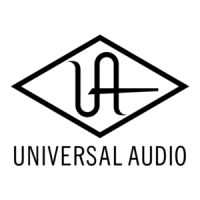7
Introduction
Analog Ears, Digital Minds
Thank you for using the 2192 Master Digital Audio Interface, the first product to combine
Universal Audio’s long history of creating high-quality vintage analog gear with its advanced
digital technology.
Conversion
The soul of the 2192 is the analog circuitry used in the A/D and D/A converters.
The analog signal path uses DC-coupled, fully dual-differential, matched-FET, all discrete Class-A
circuitry, resulting in ultra-low noise, excellent transient response and unmatched sound. No
capacitors or DC servos are used in the signal path since these degrade audio quality and
image stability, and introduce phase distortion.
Our no-compromises design approach and extensive history in analog and digital circuit design
ensure your converted signals are totally accurate and of the highest possible fidelity.
Analog to Digital
Analog signals can be converted to digital at sampling rates of 44.1, 48, 88.2, 96, 176.4, and
192kHz. The digital output signal is always 24-bit format.
During A/D conversion, the digital signal is output to all digital outputs (AES/EBU, S/PDIF, and
ADAT S-MUX) simultaneously. Audio digitized at rates above 96kHz is carried over AES/EBU in
single- or dual-wire mode, and ADAT optical I/O with S-MUX interleaving. The S/PDIF
specification, which includes 192kHz 24-bit audio, is fully implemented.
The 2192 analog outputs can be set to monitor the converted analog inputs. In this scenario the
D/A converters output the signals from the A/D converters, enabling “true confidence” analog
monitoring of the digitized signal.
Digital to Analog
Any of the digital input sources (AES/EBU, S/PDIF, or ADAT S-MUX) can be converted to
analog. The clock source used during the D/A conversion can come from the internal clock, the
digital audio source signal, or from an external clock source that is separate from the digital
audio.
D/A conversion is accomplished at the sample rate of the digital audio source signal, even if the
2192 is synchronized to an external clock source that is running at a multiple or submutiple of
the digital audio sample rate (subclock/overclock).

